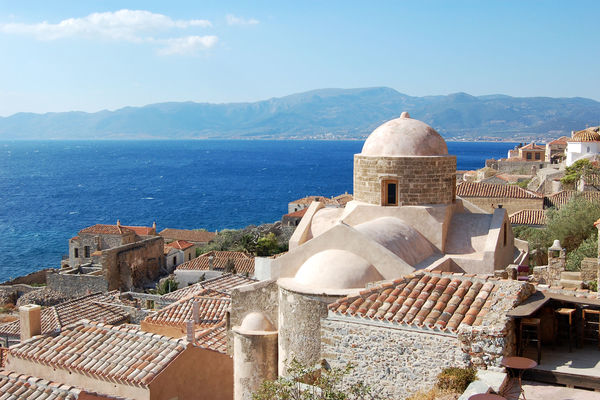The Peloponnese: Greece’s Unspoiled Escape
With its inviting towns, stunning vistas, and a rich history — but relatively few tourists — the Peloponnesian Peninsula has it all.
By Rick Steves


While most travelers to Greece head for the islands, I head for the hills — the mountains and valleys of the Peloponnese. Attached to the rest of mainland Greece by a thin isthmus, this rugged land has always seemed isolated from the rest of the country. Though most of its attractions aren't well known beyond Greece, the peninsula offers its share of fun in the eternal Greek sun, with pleasant fishing villages, untrampled beaches, bathtub-warm water, and none of the tourist crowds that plague the much-scrambled-after Greek Isles.
And though it holds some of Greece's greatest ancient sites — such as Olympia, Mycenae, and Epidavros — the Peloponnese has plenty of towns and landscapes worth seeing for their own sake.
The most charming town in the Peloponnese is easily Nafplio. Both cozy and elegant, this strollable town is, given its historical significance, surprisingly light on sightseeing, but heavy on ambience.
As the first capital of independent Greece, Nafplio has a unique pride. And although its glory days have faded, the town retains a certain genteel panache, with palm-tree waterfronts, sandy beaches, inviting shops and restaurants, and narrow, atmospheric back streets lined with stately Venetian houses. Nafplio's harbor is guarded by three castles, all wonderfully floodlit at night: one on a small island, another just above the Old Town, and a third capping a tall cliff above the city. (Nafplio also serves as a handy home base for touring the ancient ruins of Mycenae and Epidavros.) With its harborfront setting and pleasant present-day vibe, Nafplio doesn't even need tourists — and doesn't disappoint them.
The other standout on the peninsula's eastern coast, far to the south of Nafplio, is Monemvasia — a Gibraltar-like rock that juts up improbably from the sea, tethered to the mainland by a short causeway. (Monemvasia means "single entry.")
The only inhabited part of Monemvasia, its "Lower Town," hides on the seaward side of the burly rock. This remarkably romantic walled town is a museum of Byzantine, Ottoman, and Venetian history dating back to the 13th century. The perfect medieval streetscapes, made less barren with ample planted greenery, include a few lanes so narrow you might be able to feel the sun-warmed stone on both sides with outstretched hands.
Steep, zigzagging stairsteps lead up to the remains of an even bigger Upper Town, scattered across the broad, rolling plateau atop Monemvasia. In its day, this high fortress was considered the mightiest in Byzantine Greece. The last weary resident left the Upper Town nearly a century ago, and very little of it is left intact. But imagining what it must have looked like centuries ago, atop this improbable rock high above the blue deep, is a key experience on any Peloponnesian visit.
I'm particularly fascinated by the Mani Peninsula — the southernmost tip of the Peloponnese. Sealed off from the rest of the Peloponnese by a ridge of mountains, its landscape is empty like few other places in Europe are, with a sparse, almost Wild West feel. For centuries since the Middle Ages, the area was beset by pirates and brigands, forcing people to settle up in the folds of the hills, where the scarcity of arable land led to a long epidemic of violent clan feuding. And when the peninsula lost its battle for autonomy within a newly independent Greece, its people began to abandon the land en masse, while blood feuds continued to deplete the population into the 20th century.
To really delve into this rustic corner of Greece, spend a day driving the twisty road that loops around the peninsula's far end. (The area is difficult to fully experience without a car.) The farther south you go, the starker the landscape. Most of its ancient stone hill towns are all but uninhabited, like the particularly scenic Vathia, built on a rocky spur above the coastline. And yet many Mani towns feature sumptuous old fresco-slathered churches — pockets of brightness in this otherwise parched land.
If the Mani is the Wild West of Greece, the stay-a-while beach town of Kardamyli, on the Mani's northwestern shore, is the saloon where everyone goes for a drink.
Compared to your typical beach getaway, Kardamyli is an anti-resort — relaxed and relatively unspoiled, delicately mixing chic hotels and conscientious travelers with real-world Greece. Determined to keep their town's feel from being usurped by big resorts, its people have passed a law prohibiting new construction over a certain height. It also helps that its beach has pebbles instead of sand, which keeps away the party-hearty crowds.
The town works like a stun gun on your momentum. Though there's little to do here but unwind with some good food in the warm sun, most first-time visitors wish they'd planned a longer stay. I love gazing into the misty Mediterranean from here, knowing the next land south is Africa, watching the inky waves churn as the red sun sets.
With its inviting towns, stunning vistas, a rich history, and welcoming people, the Peloponnesian Peninsula has it all. Yet it is one of least explored parts of Greece. Nearly all the tourists are in Athens and the islands, while the rest of the country casually goes about its traditional business.

